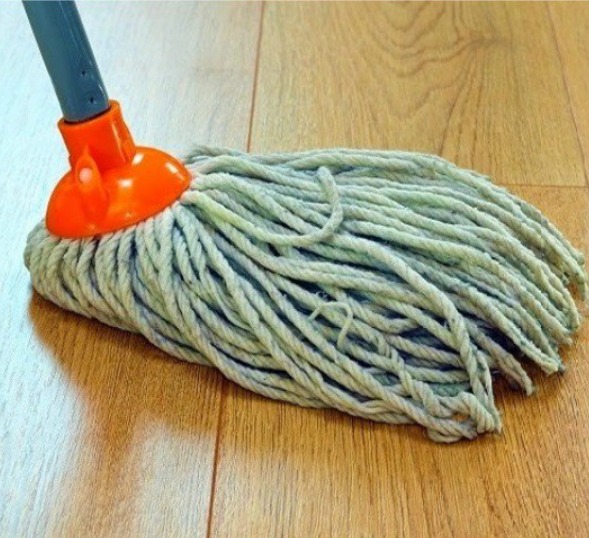ADVERTISEMENT
After soaking the mop in vinegar and water, add a few tablespoons of baking soda to the mix. The baking soda will help to further lift stains and whiten the mop head.
- How to use: Stir the baking soda into the water until it dissolves. You should start to see the water bubble slightly as the soda activates, helping to lift stains and dirt from the fibers of the mop head.
4. Scrub Away Stubborn Dirt
Use a scrub brush or sponge to gently scrub the mop head. Pay special attention to any areas that are particularly dirty or stained. The baking soda will act as a mild abrasive, helping to lift grime without damaging the fibers.
- Tip: If your mop head is particularly dirty, use a small amount of dish soap along with the baking soda to help break down grease or oil. Avoid using harsh chemicals that might damage the mop’s fibers.
5. Rinse and Repeat if Necessary
After scrubbing, rinse the mop head thoroughly under hot running water to remove any remaining dirt, soap, or cleaning solution. If your mop is still discolored or has an odor, repeat the soaking and scrubbing process until it’s clean.
6. Optional: Use Bleach for Stubborn Stains
If your mop head still has stubborn stains or remains dingy despite cleaning, you can add bleach to the cleaning process. However, use bleach sparingly and only if necessary, as it can weaken the fibers of the mop over time.
- How to use bleach: Add a small amount of bleach (about ¼ cup) to a fresh bucket of hot water and soak the mop for 15-20 minutes. After soaking, rinse the mop head thoroughly with clean water to remove all traces of bleach.
- Important Note: Always wear gloves when handling bleach and make sure to work in a well-ventilated area to avoid inhaling fumes.
7. Dry the Mop Thoroughly
After cleaning and whitening your mop, it’s important to dry it properly to prevent mold or mildew growth. Squeeze out as much excess water as possible, then hang the mop head to dry in a well-ventilated area.
- Tip: Avoid leaving the mop head in a damp, closed area like a closet or cupboard, as this can promote bacterial growth. If you have a mop with a removable head, consider placing it outside or near a fan to speed up the drying process.
- For Complete Cooking STEPS Please Head On Over To Next Page Or Open button (>) and don’t forget to SHARE with your Facebook friends
8. Regular Maintenance
To keep your mop in the best condition possible, clean it regularly—ideally after every few uses. This prevents grime from building up and makes the cleaning process much easier in the long run. Simply rinse the mop out with hot water after use, or give it a quick soak in vinegar to keep it fresh.
Alternative Methods for Special Mop Types
- Microfiber Mops: If you use a microfiber mop, avoid using fabric softeners as they can clog the fibers and reduce their effectiveness. Instead, wash the mop pads in hot water with a mild detergent. You can also soak them in a solution of vinegar and water to help break down dirt and odors.
- Cotton String Mops: For string mops, the vinegar and baking soda method works great. Be sure to thoroughly scrub the mop to ensure no dirt or debris remains in the strings.
Conclusion
A clean and white mop is not just about keeping your cleaning tools looking neat; it’s about ensuring your floors stay hygienic and spotless. By following these simple steps, you can effectively clean and whiten your mop, making it ready for its next job. Regular maintenance and cleaning will prolong the life of your mop, improve its performance, and help you achieve better results with less effort.
So, next time your mop starts to look tired and dirty, don’t worry! With a little vinegar, baking soda, and elbow grease, you can restore it to its former glory in no time. Happy cleaning!
